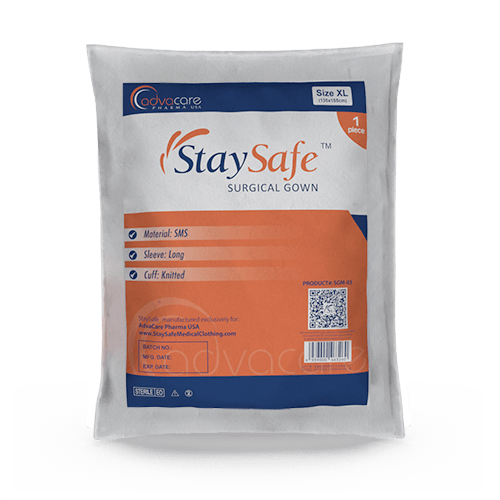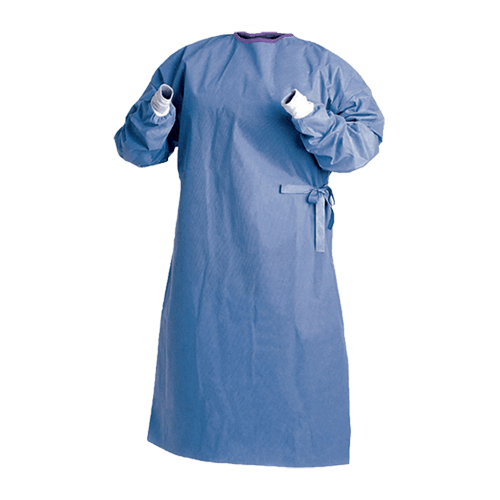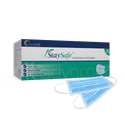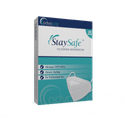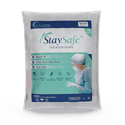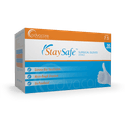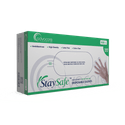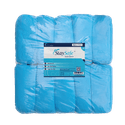Surgical Gown
Material
Fluid Protection
Collar Closure
Waist Closure
Cuff
Weight
Size
Color
Packaging
What is a Surgical Gown?
A Surgical Gown is a type of personal protective equipment (PPE) worn by healthcare professionals during surgeries or other medical procedures. This garment has been designed to prevent contamination of the patient and surgical equipment. Surgical gowns are produced in a variety of sizes, colors, and styles.
Disposable surgical gowns for doctors and other medical staff are produced in either PP (polypropylene) or SMS (spunbond-meltblown-spunbond). PP gowns offer basic protection and are lightweight, while SMS gowns are more durable and provide better resistance to fluids.
Surgical Gowns are manufactured by AdvaCare Pharma, a reputable pharmaceutical company with expertise in global distribution. This medical disposable product is carefully produced in a CE/ISO-certified facility situated in China, India, and the USA. These facilities are routinely inspected to ensure our products meet health, safety, and environmental standards.
Product Specifications
Material
Fluid Protection
Collar Closure
Waist Closure
Cuff
Polypropylene (PP)
Polypropylene (PP) surgical gowns are made of durable and lightweight polypropylene material, which is waterproof and offers protection against liquids and fluids.
PP is chemical resistant, which adds an additional layer of protection against potentially harmful substances and contamination. It is suitable for settings where protection from fluids and chemicals is crucial.
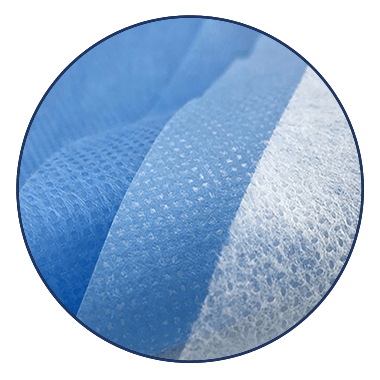
Spunbond-Meltblown-Spunbond (SMS)
Spunbond-Meltblown-Spunbond (SMS) surgeon gowns are composed of a three-layered material that consists of three layers of spunbond and meltblown fabrics. This unique combination of materials offers excellent strength and durability.
The meltblown layer serves as a protective barrier against bacteria, which enhances the gown's ability to prevent the transmission of infectious agents.
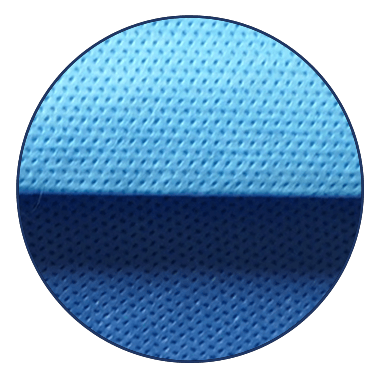
Reinforced
Reinforced surgical gowns are specialized garments for surgeons to wear during hospital surgery or the treatment of patients. These gowns feature reinforced areas, typically in the front and sleeves, that use multiple layers of fabric or additional reinforcement material, typically high-quality non-woven SMS (spunbond-meltblown-spunbond) fabric. This material provides effective fluid resistance, providing a stronger barrier against blood, bodily fluids, and other potential contaminants.
Reinforced surgical gowns meet stringent quality standards and are commonly used in operating rooms, emergency departments, and other sterile environments.
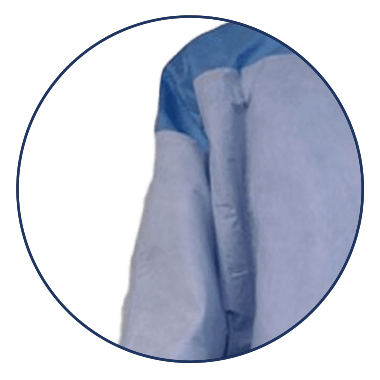
Tie-on
Tie-on collar closures are long fabric straps that can be securely tied at the back of the neck. This design provides a customizable and adjustable fit for healthcare professionals.
Tie-on closures offer versatility in sizing, accommodating various neck sizes comfortably. With this closure style, donning and doffing the isolation gown is both easy and convenient.

Velcro
Velcro collar closures are designed to provide a secure and adjustable fastening system for isolation gowns. The convenient closure style allows for easy and quick adjustment around the neck while also ensuring a comfortable and snug fit.
This closure style is highly adaptable and accommodates various neck sizes while maintaining the gown's integrity during medical procedures.
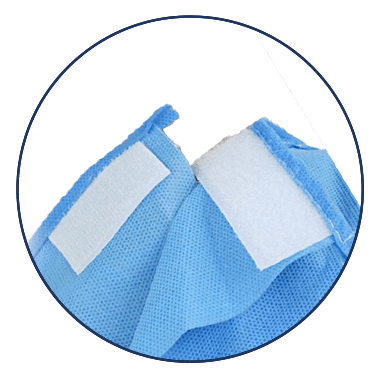
One Band
One Band waist closures utilize a single band that wraps around the waist, which offers a comfortable fit that can be easily adjusted for the individual wearing the gown.
Healthcare professionals favor this design due to its user-friendly nature. The simplicity and efficiency of the one-band styles allow for the convenient donning and doffing of the gown. It also provides proper coverage and protection during medical procedures.
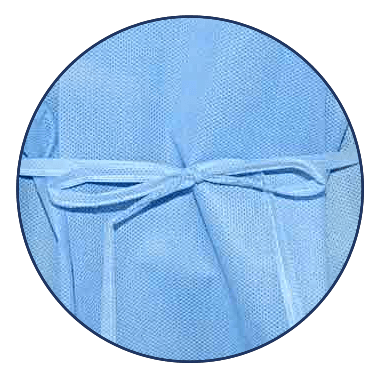
Four Bands
Four Bands waist closures feature four straps that circle around the waist. This closure style offers improved stability and better ensures that the surgical gown remains securely fastened throughout medical procedures.
The four-band design offers several benefits, including a wider range of adjustability to accommodate various body sizes and enhanced comfort.
Healthcare professionals often prefer this style of waist closure due to its ability to provide a snug and secure fit while maximizing protection and ease of movement.

Knitted
Knitted cuffs are made from a soft and stretchable fabric. They offer an additional layer of protection by acting as a barrier against contaminants.
Knitted cuffs offer a snug and comfortable fit around the wrists. The flexible and gentle nature of the material enhances the wearer's comfort while also maintaining the integrity of the surgical gown.
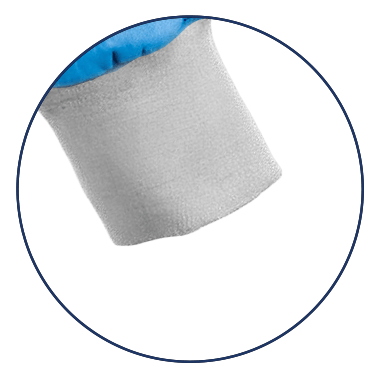
Elastic
Elastic cuffs are made from a resilient elastic material. They have been designed to provide a secure and comfortable fit around the wrists. By forming a secure seal, this style reduces the possibility of contaminants entering the sleeves.
Elastic cuffs offer a practicality and reliability that is favored by many healthcare professionals.

Why are we a leading Surgical Gown manufacturer?
AdvaCare Pharma is a leading pharmaceutical company that excels in manufacturing Surgical Gowns and other single-use medical devices for surgical procedures. We prioritize the production of high-quality, cost-effective PPE medical supplies. Our highly-skilled team works with our distributors to deliver customized solutions catering to the unique requirements of each market.
Over the past twenty years, we have established ourselves as a trusted and reliable exporter and manufacturer of Surgical Gowns and other medical disposables. Our partnerships include distributors, hospitals, pharmacies, and other many other institutions.
Uses
What is a Surgical Gown used for?
A Surgical Gown prevents the transmission of microorganisms and preserves a sterile environment during surgical procedures. Surgical gowns act as a protective barrier between the surgical team member and the patient, guaranteeing that no contaminants from the healthcare provider come into contact with the patient's open surgical wounds or body cavities.
When creating a physical barrier, these gowns minimize the risk of introducing infectious agents into the surgical site, thereby contributing to patient safety and reducing the likelihood of post-operative infections.
How is a Surgical Gown worn?
Wearing a surgical gown is a meticulous process:
- Before donning a surgical gown, healthcare professionals must prioritize hand hygiene. This involves thoroughly washing their hands with soap and water or using an alcohol-based hand sanitizer to eliminate any potential contaminants on their hands.
- Once hand hygiene is assured, the healthcare provider proceeds to put on the surgical gown. This entails inserting their arms through the gown's sleeves and checking they extend fully to cover the wrists.
- Any ties or closures on the gown should be securely fastened to maintain proper coverage and reduce the risk of exposure.
- The surgical gown must completely cover the healthcare provider's chest and back to create a comprehensive barrier.
- The gown should undergo a visual inspection for any visible defects, such as tears or holes, before use.
- If any such damage is detected, the gown should be promptly discarded to eliminate the risk of contamination and uphold the integrity of the sterile environment.
How should unused Surgical Gowns be stored?
Unused surgical gowns should be stored with great care to keep their sterility and protective properties. They must be kept in a clean and dry area, safeguarded from direct sunlight, heat sources, exposure to chemicals, and moisture. These environmental precautions are required to prevent any potential contamination of the gowns, which could compromise their efficacy during surgical procedures.
Storing unused surgical gowns in their original packaging is highly recommended, as it provides an extra layer of protection and minimizes the risk of damage or contamination. By adhering to these storage guidelines, healthcare facilities can guarantee that surgical gowns are readily available for use when needed while preserving their integrity and quality.
What are the key features of a Surgical Gown?
Surgical gowns have durable material options like polypropylene (PP) or spunbond-meltblown-spunbond (SMS), various levels of fluid protection (standard or reinforced), collar closures such as tie-on or Velcro, waist closures (one band or four bands), cuff styles (knitted or elastic), different weights, sizes ranging from S to XXL, and a choice of colors like blue, green, or yellow. These features allow for customization based on specific procedural needs and individual preferences.
FAQs
When should Surgical Gowns be used?
Surgical gowns are commonly worn by surgeons, nurses, and other members of the surgical team in all surgical settings where invasive procedures are performed, including hospitals, clinics, and ambulatory surgical centers.
What are the benefits of PP versus SMS Surgical Gown?
PP surgical gowns are lightweight, breathable, and cost-effective. They provide a good level of protection against fluids and particulate matter, making them suitable for procedures with minimal fluid exposure. SMS surgical gowns are made up of multiple layers and offer a higher level of fluid resistance and better protection against liquid penetration. They are often preferred for procedures with a higher risk of fluid exposure.
What is the difference between a standard Surgical Gown and a reinforced Surgical Gown?
Standard and reinforced surgical gowns differ in their level of barrier protection. Standard gowns are more suitable for procedures with minimal fluid exposure, such as routine surgical procedures. Reinforced gowns have been constructed with additional reinforcement in critical areas like the front chest and sleeves. This type of garment is preferred for procedures with a higher risk of fluid contact, such as during orthopedic surgeries.
What are the key features and benefits of your Surgical Gowns compared to other brands?
- Superior Protection: Our gowns offer advanced barrier protection against fluids and pathogens, ensuring a safe surgical environment for healthcare professionals and patients alike.
- Comfort and Mobility: Designed with ergonomic considerations, our gowns prioritize comfort and mobility, allowing surgeons and medical staff to move freely during procedures without compromising safety.
- Quality Materials: Crafted from high-quality materials, our gowns are durable, tear-resistant, and breathable, providing long-lasting performance and reliability in demanding healthcare settings.
- Compliance and Certification: Our surgical gowns meet or exceed industry standards for safety, quality, and regulatory compliance, backed by certifications and testing to guarantee adherence to stringent healthcare guidelines.
- Cost-Effectiveness: Despite their superior quality and performance, our surgical gowns offer cost-effective solutions for healthcare facilities, providing value for money without compromising on safety or comfort.
Can I order customized configurations of your Surgical Gowns?
Yes, we offer customization options for our surgical gowns to accommodate specific user preferences and clinical requirements. We employ agile production methods to increase our manufacturing capability specifically to offer a wider range of specifications that can meet the needs of every market.
Do your Surgical Gowns bear the CE mark?
Yes, our surgical gowns are CE marked, indicating compliance with European Union regulations for medical devices. We also strictly adhere to ISO standards in the manufacture of all medical devices. Many of our medical devices also possess USFDA certification.
What complexities are involved in importing Class II medical devices for distribution?
Importing Class II medical devices may involve more regulatory oversight than Class I devices; however, with proper documentation and compliance, they can still be imported for distribution. Our Regulatory Affairs Department provides expert assistance to ensure efficient registration in the target country.
References
Surgical Team Member's Application of Personal Protective Equipment: An Observational Study
This study examines the application of PPE by surgical team members and identifies areas where the use of protective clothing, such as gloves, gowns, and aprons, could be improved. The findings suggest that healthcare facilities can enhance infection control practices through better adherence to PPE guidelines.
Cost-effectiveness and cost components of pharmaceutical and non-pharmaceutical interventions affecting antibiotic resistance outcomes in hospital patients: A systematic review
This study, published by K Allel Henriquez, MJ Hernández-Leal, and others in BMJ Global Health in 2024, explores the cost-effectiveness of various interventions, including the use of medical gowns, in controlling antibiotic resistance in hospital settings. The study highlights the importance of infection control measures, such as hand hygiene and gown usage, in managing Methicillin-resistant Staphylococcus aureus (MRSA) infections. It provides an in-depth analysis of the costs associated with these interventions and their impact on antibiotic resistance outcomes.

You might be interested in...
Why AdvaCare Pharma?
As an industry leader, we are aware of our responsibility to provide affordable and sustainable solutions to improve healthcare worldwide.
